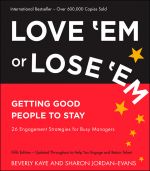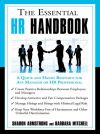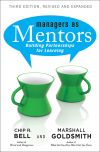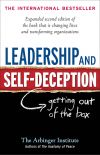Правообладателям!
Представленный фрагмент книги размещен по согласованию с распространителем легального контента ООО "ЛитРес" (не более 20% исходного текста). Если вы считаете, что размещение материала нарушает ваши или чьи-либо права, то сообщите нам об этом.Читателям!
Оплатили, но не знаете что делать дальше?
Текст бизнес-книги "Love 'Em or Lose 'Em. Getting Good People to Stay"
Автор книги: Sharon Jordan-Evans
Раздел: Зарубежная деловая литература, Бизнес-книги
Возрастные ограничения: +12
Текущая страница: 1 (всего у книги 2 страниц)
Beverly Kaye, Sharon Jordan-Evans
Love ’Em or Lose ’Em
More Praise for Love ’Em or Lose ’Em
“You just have to love Love ’Em or Lose ’Em. This charming, clever, practical, and user-friendly book is a great deskside coach for anyone who manages people.”
– Rosabeth Moss Kanter, Chair and Director, Advanced Leadership Initiative, Harvard University
“Talent matters. Few dispute this truth. But keeping great talent continues to be a challenge for many companies. This marvelous book offers numerous specific tools and hundreds of examples of how to care for people. Love ’Em or Lose ’Em is the best treatise on retaining talent available.”
– Dave Ulrich, Professor, Ross School of Business, University of Michigan, and coauthor of HR from the Outside In: Six Competencies for the Future of Human Resources
“Fantastic, fun, and practical coaching advice! This stuff works! Great for executives to use with their teams – and buy for their managers! Buy it! Use it! Share it! Keep good people.”
– Marshall Goldsmith, author of Mojo: How to Get It, How to Keep It, How to Get It Back If You Lose It
“The manager-employee relationship is the difference between retention and turnover. Good leaders know how to hold on to their team members by striking a balance between leadership and management. The trick is to publicly praise employees for their victories and privately coach them on their opportunities. Love ’Em or Lose ’Em helps create the foundation for doing just that.”
– Ken May, former President and CEO, FedEx Kinko’s
“At First Data, the Love ’Em or Lose ’Em concepts have become an integral part of our ongoing global retention and engagement strategy and one of our most widely attended manager training programs. The book is full of practical employee engagement strategies, coaching, and advice that can be easily applied by any manager and applicable to employees at all levels. With the additional global perspectives in this newest edition, the relevance of the Love ’Em or Lose ’Em messages is now truly boundaryless.”
– Michelle Prince, Vice President, Human Resources, First Data
“A great read! Having had the opportunity to spend two days in a ‘Love ’Em or Lose ’Em’ seminar, I am a believer! It makes no difference what business you are in (corporate/government/military), people are the single most important part of an organization, and they are at the core of the success or failure of an organization!”
– William (Bill) Pickavance, former Vice President for Launch and Recovery Systems and Florida Site Executive, United Space Alliance
“I’m a big fan of the ‘stay interview’ and its power; nothing speaks louder than a manager who genuinely cares. That’s just one great idea from this latest edition of Love ’Em or Lose ’Em, which should be on every manager’s bookshelf or tablet or smart phone!”
– Rebecca Ray, Senior Vice President of Human Capital, The Conference Board
“I have long believed love is at the deepest center of leading oneself and others, and to find a book that provides specific and practical ways for managers to pay attention to their talent is truly a gift. How one leads is a choice, and in this gem of a read are powerful reminders of how managers can show up and be present to their people, particularly if they want to bring out the best in others, keeping them engaged and inspired to stay and contribute to their fullest potential. This book deserves to be read at least once a year or kept nearby as a guide.”
– Teresa Roche, Vice President and Chief Learning Officer, Agilent Technologies
“I found the authors’ approach to be very practical with many ideas I can put to use immediately. This book helped me adjust my understanding of American management principles.”
– Hiroyuki Hirano, General Manager, Suzuyo & Co., Ltd
“I’ve been so impressed with the millennials entering our workforce around the world. This book is full of great tips for getting their best discretionary effort – love them and you will be a beloved manager.”
– Tina Sung, Vice President, Government Transformation and Agency Partnerships, Partnership for Public Service
“Ever since the first edition, Love ’Em or Lose ’Em has been a great source of inspiration to me. I warmly recommend this pragmatic book to anyone who manages others – and especially to those who still believe that talent retention is all about money, which it is really not! This book offers a powerful and engaging way to achieve active and sustainable talent retention. And it’s exciting to see that it works all across the globe!”
– Michael Zollinger, Head HR Generalists, Swiss Re
“Marriott’s global engagement strategy includes asking associates worldwide about their work environment and then providing resources to guide them through the key drivers of engagement and retention in the workplace. As a global resource in Marriott’s engagement strategy, Kaye and Jordan-Evans once again provide a powerful, globally inclusive book that is both impactful and relevant.. practical, associate-centric ideas that work!”
– Steve Bauman, Vice President, Global Learning Deployment, Marriott International
“If you need a practical and effective way to retain and engage your talent, look no further than Love ’Em or Lose ’Em: the A to Z for managers and leaders who care about their employees enough to take action that delivers results. Having witnessed, firsthand, the power of the ‘stay interview’ and the impact of simply asking employees what will keep them in the organization, I know the rewards contained within Love ’Em or Lose ’Em are easily attained. Finding talent can be hard in today’s competitive world. Keeping that talent can be deceptively easy.”
– Andrew Buckingham, Head of Global Learning and Development, Genzyme UK
“Our global strategy is based on recruiting and developing the best talent. Retaining and engaging that talent on a global basis is crucial to every manager’s business goals. Love ’Em or Lose ’Em has become their playbook. Our managers believe in the concept and their behaviors are consistent – it has become part of our lexicon. And most importantly, employees are responding!”
– J. Craig Mundy, Corporate Vice President, Enterprise Learning & Talent Management, Ingersoll Rand
“Love ’Em or Lose ’Em has significantly contributed to our business in Latin America by setting ground rules and providing practical tools and techniques to our leaders who constantly transform our organization. The wonderful principles in this book have raised our sensitivity on how to interpret our associates’ needs, and once put in practice, they have enabled powerful results. It is a very dynamic and updated consultation book I have valued throughout my career at Pepsico.”
– Carolina Lazarte, Human Resources Director, Latin America North, D&I LAB, Pepsico Latin America Beverages
To my beloved parents. Abe and Mollie Kaye truly lived a seven-decade love story. They inspired me personally and professionally throughout my life and are truly missed!
– Bev
To my kids and their kids. You continue to teach me what “lovin’ ’em” is all about. I do love you!
– Sharon
LOVE ’EM OR LOSE ’EM
A PROVEN APPROACH TO LEADING
It’s a power button.
For over a decade we’ve watched leaders at all levels and in all parts of the globe use a love ’em approach to building loyal, committed, productive teams. All that in an era when some said (incorrectly) that loyalty is dead. Their employees cannot be enticed away by a 10 percent raise or a gym or a massage on Fridays. They love their jobs, their teams, their bosses, and yes, their companies. And because of that, their companies win.
.. not a toggle switch
In contrast, we’ve seen leaders lose talent regularly and unnecessarily. In some cases these not-so-successful leaders matched their engagement and retention efforts to economic highs and lows. In the good times, when jobs were plentiful and talented people had choice, managers offered perks, praise, and promotions. In bad times, these leaders developed a cavalier attitude about their employees. Many felt – and some actually said – “Quit whining – be glad you have a job.” In every case, they failed to use the love ’em approach.
So what is the love ’em approach in a nutshell? It’s a mindset, a philosophy of dealing with people and a way of effectively managing them. Some people told us the word love would not be accepted in the business world. We tried, and we failed to find an alternative – another word that stood for so much. Love ’em leaders genuinely care about their people. They appreciate, nurture, grow, recognize, challenge, understand, and respect them. And they believe this is the job of being a leader.
In contrast, non–love ’em leaders are more apt to ignore their employees, tell them what to do and when to do it, expect obedience, fail to respect them, thank them, challenge them, care about them. Ultimately, they believe the love ’em approach is not part of their job.
What’s the payoff with the love ’em approach?
You might wonder why you’d bother to care more, listen more, develop more. What’s in it for you? For the organization? Whether you manage one or hundreds of people, our research and others’ definitively show that you can influence those things that keep people engaged, on your team, and producing at their peak. You have more power and influence in the employee engagement and retention equation than anyone else! And engaged, highly productive employees help you, your team, and your organization excel.
Four important words that drive the message
Readers of our book (this is our fifth edition) have loved the title Love ’Em or Lose ’Em: Getting Good People to Stay. But it’s not just a catchy title. The words drive the heart of our message. Here’s how we’re using these words:
Love
It’s easy. Treat employees fairly and respectfully. Listen to them. Help them get what they want and need. Thank them. Challenge and develop them. Care about them, and you will engage and retain them.
Lose
Loss is just as serious when talent retires on the job as when they leave to join a competitor.
Good
Consider your solid citizens, not just your high-potentials. Stars are people at any level who bring value to the organization.
Stay
Encourage talented employees to stay with the enterprise (if not your own department). Talent will be the key differentiating factor in the competitive battle ahead.
Research Base
Global research supports this approach. We use exit interview information, focus groups, and the Internet. We (and dozens of helpers) continually scan newspapers, journals, and books. We deliver the love ’em message to managers worldwide, and we learn directly from them and from their employees– what works and what doesn’t.
We ask the question “What kept you?” everywhere.
Our analysis of that data helped us form the original 26 strategies and chapters A–Z. We’ve built on that original research, meeting with more than half a million managers from large and small companies around the world. We’ve listened, consulted, provided training, and learned from them. We continually update our “What Kept You” database (more than 18,000 respondents). All of this helps us refine and expand our engagement and retention strategies.
What’s in this book for you?
Love ’Em is universal.
The suggestions throughout the book should work as well in India as they do in Idaho, with appropriate customization for cultural, language, or individual differences.
Love ’Em is timeless.
The love ’em approach works as well in 2020 (we plan to be around!) as in 1999 (first edition).
Love ’Em is timely.
For the fifth edition, we’ve updated the stories, statistics, and workplace views so that they are relevant for you as a manager now.
Updated content for you:
• Practical to-do lists
• Multiple business examples about what worked to engage and retain talent around the globe
• Real-life “alas” stories about losing solid performers
New for you:
• More stats, stories, and cultural references from global contributors
• A ponderable at the beginning of every chapter, to introduce key themes and to spark your thinking
• A “Calling All Managers of Managers” section in the back matter, to highlight what leaders can do to strengthen the engagement/retention skills of the managers who report to them
We’ve kept the navigation tools in the book that you find helpful:
• Helpful “go to” icons linking to more ideas about what interests you most
• A retention/engagement index (REI) to guide your learning (moved to the beginning of the book so you won’t miss it!)
Make this yours
We wrote Love ’Em or Lose ’Em to make your life easier, to help you in a realtime, day-to-day way. We wrote it because you make such an impact on the lives of your workforce. That’s an awesome responsibility that deserves all the help and support it can get.
★ Create and implement your own, unique version of the love ’em approach.
★ Use this as your guide – as you would use a GPS.
★ Return to it again and again.
★ Dog-ear the page corners.
★ Use a highlighter on what matters most to you.
★ Put a bookmark in key chapters, and leave the book on your own manager’s desk!
★ Personally commit to implementing the key message of just one chapter. Start by reading Ask and Buck – then go anywhere you want.
Bottom line: make the love ’em approach your daily practice
The Love ’Em or Lose ’Em approach to engaging and retaining talent is not something you turn on and off, syncing to the latest economic blip and the corresponding concern about keeping talent.
It works best when it’s authentic and perennial, when you clearly believe in it and demonstrate it daily in your actions with the people you want on your team.
Talent is everything. As a manager, you know that. You need your talented people to stay with you. These people are critical to your success. And your competitors want them!
So how will you keep them engaged? Excited about coming to work and performing at their peak? How will you get them to stay (both psychologically and physically) while others try to entice them away? Love ’Em or Lose ’Em will show you how.
HOW TO READ THIS BOOK
How do you like to read a book? Start at the beginning and read to the end? Start at the end, and then circle back to the beginning? Skim, scan, and then dive in when a topic really grabs your interest? Any of these approaches will work fine with Love ’Em or Lose ’Em.
In any case, we’d recommend you read Ask and Buck early, as these two chapters support all the others. They introduce you to the love ’em approach, teach you how to hold stay interviews, and get you thinking about the crucial role you play in the engagement/retention challenge.
We also suggest you take just a few moments to check out your beliefs about managing, engaging, and retaining others by completing a manager self-test called The Retention/Engagement Index (REI). The results will direct you to chapters you might want to read soon.
What’s Your REI?
Research shows that your perspectives and beliefs about managing others and the resulting actions you take can predict the likelihood that talented people will not only continue to work for you but will bring their discretionary effort to work each and every day. They’ll help you and your organization do what you’re trying to do!
This survey allows you to evaluate your beliefs and mindsets about engaging and retaining the people you can least afford to lose.
Use this scale to rate yourself (1–4) on the extent to which you believe or act in the ways listed here.
1 = Always/Definitely Yes
2 = Often/Frequently
3 = Sometimes/Occasionally
4 = Never/Definitely No


So, how did you do? Here is how to make sense of the test, gauge your overall strength as a love ’em manager, and decide which chapters to read first.
1. Highlight beliefs or behaviors for which you scored a 1 or 2.
2. Turn to the corresponding A–Z chapter.
3 . Pick up some hints and tips about how to increase your effectiveness in those areas.
Now, note how you’re doing overall by adding up your total score and using these interpretation guidelines:
High 80–104: Good job. You have the love ’em mindset and are probably taking many of the actions needed to engage and retain your talent.
Medium 53–79: Beware. You’re at risk for losing your best people. Some may have already left you. Take stock and take action before you lose more talent.
Low 26–52: Look out! You’re at high risk for losing talent – you might even have a “swinging door.” Your beliefs and corresponding actions (or inactions) may be standing in the way of having engaged people who want to stick around and work for you over time. You need to take immediate, focused action.
This book exists to help you increase your score – the one you just gave yourself in this self-test – and the one your employees give you every day.
When your REI goes up, so do your talented employees’ job satisfaction levels, motivation, and loyalty.
Time to dive in!
ONE
Ask
WHAT KEEPS YOU?
Ponder this: Do you know what they really want?
When do you think most leaders ask questions like “What can I do to keep you?”
You’re right: it’s in the exit interview. At that point it’s typically too late. The talented employee already has one foot out the door!
Have you ever wondered why we ask great questions in exit interviews but neglect to ask early enough to make a difference? Love ’em leaders do ask. They ask early and often, they listen carefully to the answers, and they link arms with their talent to help them get more of what they want, right where they are.
Conduct Stay Interviews
A crucial strategy for engaging and retaining talent is having conversations with every person you hope will stay on your team. We coined the term stay interview to describe those chats. If you hold stay interviews, you’ll have less regrettable turnover and fewer exit interviews!
When we suggest asking employees why they stay or what would keep them, we hear, “You’ve got to be kidding,” “Isn’t that illegal?” or “What if they give me an answer I don’t want to hear?” Managers dance around this core subject usually for one of three reasons:
• Some managers fear putting people on the spot or putting ideas into their heads (as if they never thought about leaving on their own).
• Some managers are afraid they will be unable to do anything anyway, so why ask? They fear that the question will raise more dust than they can settle and may cause employees to expect answers and solutions that are out of the managers’ hands.
• Some managers say they don’t have the time to have these critical one-on-one discussions with their talented people. There is an urgency to produce, leaving little time to listen, let alone ask. (If you don’t have time for these discussions with the people who contribute to your success, where will you find the time to interview, select, orient, and train their replacements?)
Guessing Is Risky
What if you don’t ask? What if you just keep trying to guess what Tara or Mike or Akina really wants? You will guess right sometimes. The year-end bonus might please them all. Money can inspire loyalty and commitment for the near term. But if the key to retaining Tara is to give her a chance to learn something new, whereas Mike wants to telecommute, how could you ever guess that? Ask – so you don’t have to guess.
Alas

A senior manager told us of an employee who was leaving his company. On her last day, the senior manager, who was upset at the loss, expressed his disappointment that she was leaving. He wished her well but said, “I wish there were something we could have done to keep you,” assuming that her direct supervisor had asked what would make her stay. But the supervisor hadn’t asked, and something could have been done. The employee said she would have stayed if she could have been more involved in some of the new task forces, as she felt the participation was vital to her goal of growing her career. It was a request that would have been easy to fill – if only he had known!
Asking has positive side effects. The person you ask will feel cared about, valued, and important. Many times asking leads to stronger loyalty and commitment to you and the organization. In other words, just asking the question is an effective engagement and retention strategy.
How to Ask
How and when do you bring up this topic? How can you increase the odds of getting honest input from your employees? There is no single way or time to ask. It could happen during a developmental or career discussion with your employees. (You do hold those, don’t you?) Or you might schedule a meeting with your valued employees for the express purpose of finding out what will keep them. One manager sent the following invitation to give his key people some time to think and to prepare for the conversation:
You are invited to attend
.. the next step in your continued development
You make a difference and I value your contributions
Let’s discuss some things that are important to you and me:
What will keep you here?
What might entice you away?
What is most energizing about your work?
Are we fully using your talents?
What is inhibiting your success?
What can I do differently to best assist you?
Please schedule a meeting with me within the next two weeks to discuss this and anything else you’d like to talk about
Regardless of when you start this dialogue, remember to set the context by telling your employees how critical they are to you and your team and how important it is to you that they stay. Then find out what will keep them. Listen carefully to their responses.
Правообладателям!
Представленный фрагмент книги размещен по согласованию с распространителем легального контента ООО "ЛитРес" (не более 20% исходного текста). Если вы считаете, что размещение материала нарушает ваши или чьи-либо права, то сообщите нам об этом.Читателям!
Оплатили, но не знаете что делать дальше?







